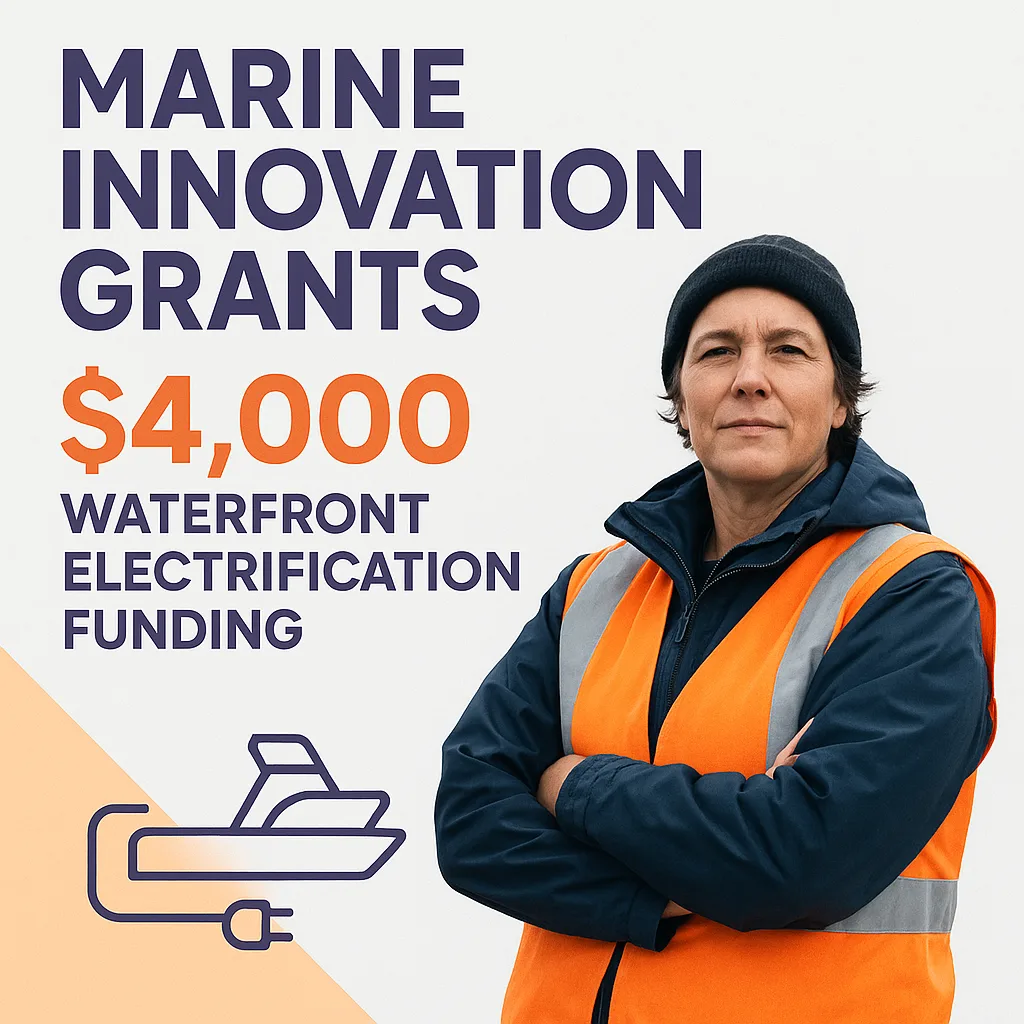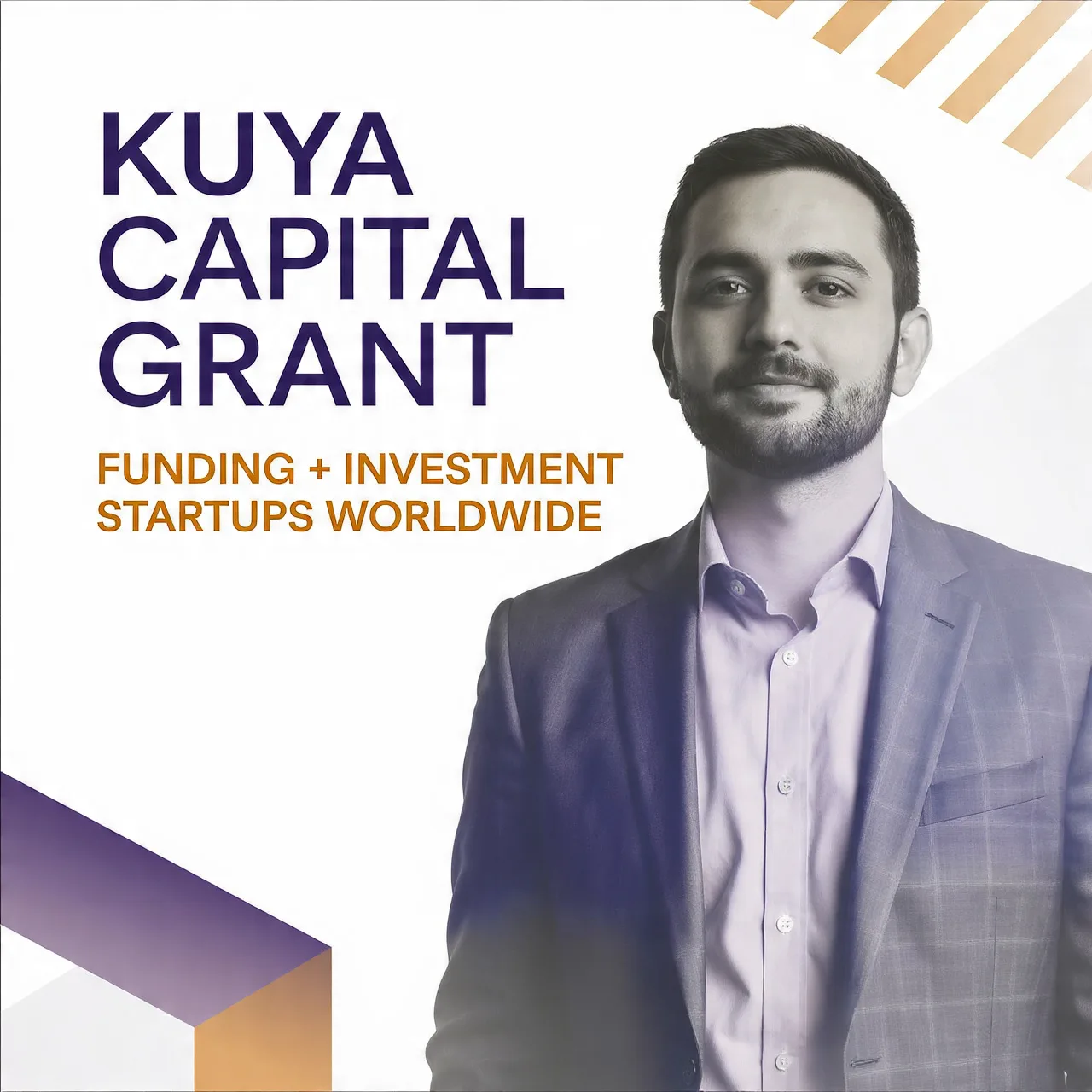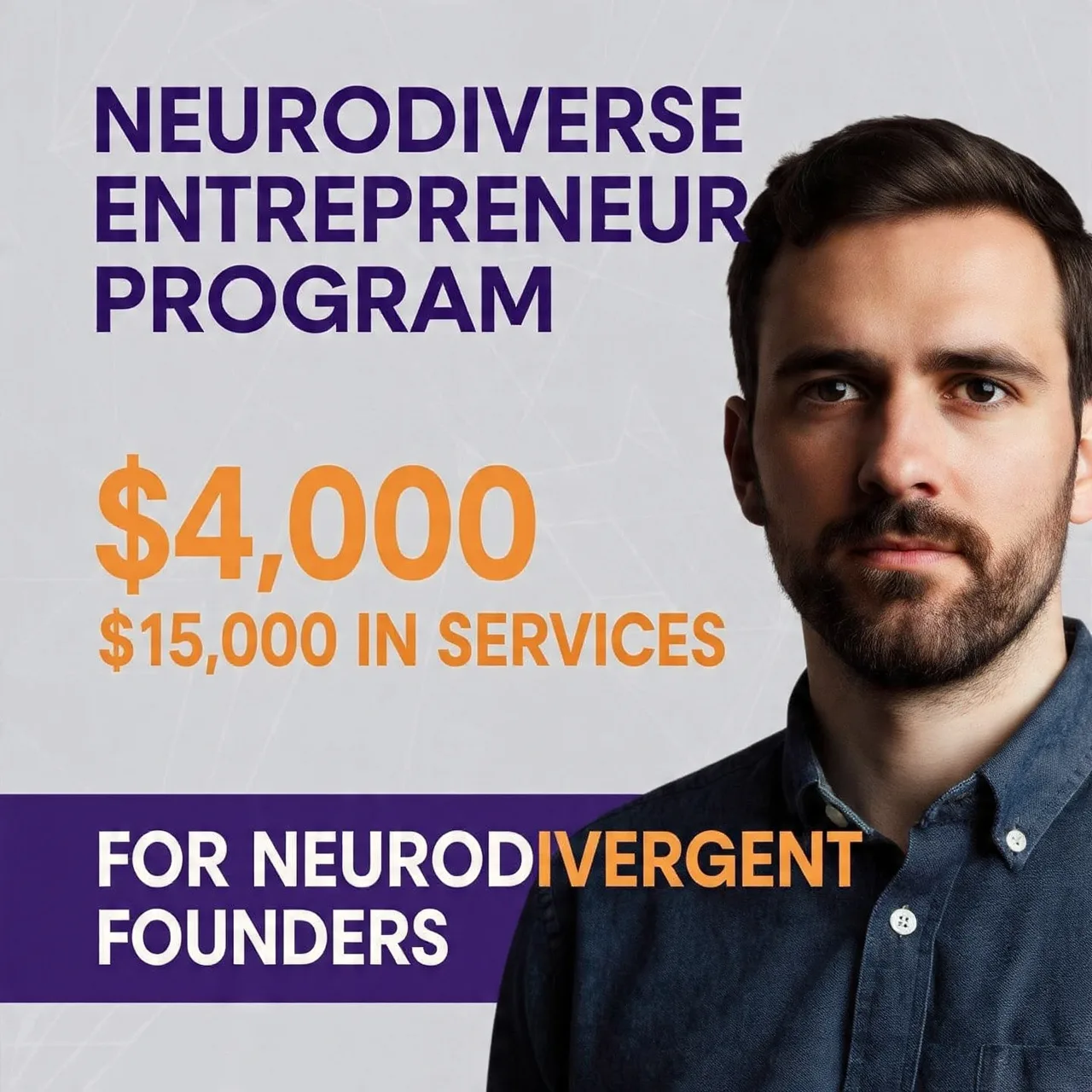
Island Institute Marine Innovation Grants – Secure Electric Boat Funding for Maine
$4,000 for Maine working waterfront electric outboards, solar power & charging infrastructure. Quarterly reviews. Apply today!
Grant Overview
Get $4,000 for Electric Outboards, Solar Power & Charging Infrastructure on Maine’s Working Waterfront

Here’s something you probably didn’t know about Maine’s fishing industry: the average lobster boat burns through about $15,000 worth of fuel every season. With more than 100,000 registered boats in the state of Maine, there’s a lot of opportunity for change – and the Island Institute Marine Innovation Grants are putting real money behind that opportunity.
This grant gives up to $4,000 annually to working waterfront businesses ready to make the switch to electric propulsion systems. But here’s the thing most people miss about this funding – it’s not really about being green (though that’s nice). Like other business transformation grants, it’s about staying profitable when fuel costs keep climbing and equipment keeps breaking down.
The Island Institute has been around since 1983, working specifically with Maine’s most remote coastal communities. When Philip Conkling and Peter Ralston founded Island Institute in 1983, they recognized that Maine’s island and coastal communities were facing a distinct set of challenges shaped by time and place. What started as a response to declining fish catches has evolved into something much bigger – they’re now leading Maine’s transition to electric marine propulsion.
Why This Grant Actually Makes Financial Sense
Let me be honest with you. Most environmental grants are feel-good programs that don’t really solve business problems. This one’s different because it came out of real conversations with real fishing families who were getting hammered by fuel costs. Similar to other practical business grants, the Marine Innovation program focuses on immediate operational benefits.
The numbers tell the story better than any environmental pitch. An electric outboard motor costs about $8,000 to $12,000 upfront, but eliminates roughly $3,000-5,000 in annual fuel costs for most commercial operations. Add in reduced maintenance (no oil changes, fewer moving parts), and you’re looking at payback in 2-3 years. The Institute will identify potential funding mechanisms and assist privately-owned working waterfront businesses in navigating the challenging processes to access this kind of transformative technology.
The grant requires a 50% match from for-profit businesses, but here’s where it gets interesting – they can waive that requirement based on financial need or if you’re working with new technology applications. Just like other flexible funding programs, the real goal is getting proven solutions into the hands of people who need them.
What Projects Actually Get Funded
I’ve looked at the track record, and there’s a clear pattern to what wins funding. Electric outboard motors top the list, especially for lobster boats and aquaculture vessels that do a lot of short-distance hauling. Solar installations on processing facilities and docks come in second. Battery storage systems for off-grid operations round out the most successful project types.
The key word in their criteria is “highly visible.” Unlike grants that fund individual entrepreneurs in isolation, Island Institute wants projects that other marine businesses can see and potentially replicate. A lobster wharf that installs solar panels and boat charging stations becomes a demonstration site for the whole harbor.
Here’s something most applicants don’t realize – they’re not just funding equipment purchases. Island Institute’s deep expertise and leadership, this resource is built to help you make the switch to climate-friendly electric propulsion includes ongoing technical support and access to their marine electrification toolkit.
Q: Can fishing cooperatives apply for multiple projects?
A: Yes, each eligible entity can receive up to $4,000 per fiscal year.
Q: What about aquaculture operations?
A: Sea farms are specifically listed as eligible applicants.
Q: Is there priority for certain types of boats?
A: Priority goes to highly visible projects with clear community impact.
The Application Timeline That Most People Get Wrong
Applications get reviewed quarterly – September 1st, December 1st, March 1st, and June 1st. Most people think this means you should submit right before the deadline. Wrong approach. Like other competitive funding programs, applications submitted well before the quarterly deadline give reviewers more time to ask clarifying questions and actually engage with your project details.
The rolling application window runs through June 1, 2026, but don’t wait until spring 2026 to apply. Island Institute works with Maine’s most rural, remote and resource strapped island and coastal communities, and they prioritize businesses that are already engaged with business resiliency planning. That takes time to develop.
Common Mistakes That Kill Applications
Here’s where most applications fall apart: they focus on environmental benefits instead of operational advantages. The grant reviewers understand that working waterfront businesses need immediate returns on investment. Unlike emergency assistance programs, this funding is designed to improve long-term business sustainability.
Another killer mistake is underestimating installation complexity. An electric outboard isn’t just a drop-in replacement for a gas motor. You need charging infrastructure, possibly electrical system upgrades, and operator training. Successful applications address these comprehensive requirements with specific technical details.
The biggest error I see is generic equipment requests without explaining the specific operational problem being solved. Just like grants that require detailed impact explanations, Island Institute wants to fund solutions, not just purchases.
Q: Should I include cost comparisons in my application?
A: Absolutely – operational cost savings over 5 years.
Q: How technical should my installation plan be?
A: Detailed enough to show you understand the full scope of work required.
Q: Can I apply for charging infrastructure without buying a boat?
A: Yes, shoreside charging infrastructure is explicitly eligible.
Q: What about hybrid systems?
A: The grant focuses on full electrification and renewable energy projects.
Beyond the $4,000 – What This Funding Really Provides
The money itself is just the starting point. Recipients get access to Island Institute’s marine electrification network, which includes other early adopters who share practical knowledge about what works and what doesn’t in real marine conditions. We solve real world problems with practical solutions and an innovation mindset – and that approach extends to ongoing support for grant recipients.
Most significantly, funded projects become case studies that influence broader industry adoption. Commercial fishermen are dependent upon safe, stable, reliable, and accessible working waterfronts for numerous aspects of their lives, and successful electrification projects help prove that new technology can meet those reliability requirements.
The Institute also provides technical assistance beyond the grant period. Unlike general funding databases, they maintain relationships with recipients and help troubleshoot implementation challenges that inevitably come up with new technology.
Strategic Timing for Maximum Impact
Here’s something most people miss about grant timing: applications submitted in late summer (August-September) compete with fewer other projects because many businesses are focused on peak season operations. Applications submitted in winter months face more competition but benefit from reviewers having more time for detailed evaluation.
The Tom Glenn Community Impact Fund that supports this grant represents a multi-year commitment to marine electrification. Maine’s working waterfronts are facing a complex blend of challenges, and this funding addresses both immediate operational needs and longer-term community resilience planning.
Priority goes to businesses already working with Island Institute on climate planning projects, but that doesn’t mean new applicants can’t win funding. Similar to other geographically-focused grants, the key is demonstrating understanding of local marine industry challenges and how electrification addresses them.
Making Your Application Stand Out
The applications that win funding tell a story that connects immediate business needs with broader community impact. They don’t just ask for money to buy equipment – they explain how that equipment solves specific operational problems while creating a model for other businesses to follow.
Successful applicants also demonstrate they’ve done their homework on electric marine technology. Conditions on the water vary far more widely than conditions on roads, making it harder to prove how well electric boats can handle the range and hauling capacity required of them. Your application needs to show you understand these challenges and have realistic plans for addressing them.
The best applications include letters of support from other waterfront businesses, harbor masters, or municipal officials who can speak to the project’s broader community value. Just like professional grant writing services recommend, third-party endorsements significantly strengthen funding requests.
Q: How long should the application take to complete?
A: About 20 minutes once you have all required information assembled.
Q: Can municipalities apply for harbor-wide projects?
A: Yes, municipalities are eligible applicants for marine infrastructure projects.
Q: What about tribal governments?
A: Tribal governments are specifically listed as eligible applicants.
Q: Is there preference for first-time electric adopters?
A: Priority goes to projects with high environmental and financial benefits regardless of previous experience.
This is exactly the kind of strategic, technical funding opportunity where professional application support makes the crucial difference between winning and losing. The Marine Innovation Grant requires demonstrating technical competence, financial planning, and community impact – elements that benefit enormously from experienced guidance. If you’re serious about electrifying your waterfront operation and want expert help crafting a winning application, CLICK HERE to get GRANT PROPOSAL WRITING help that positions your project for success.
Donor: Island Institute (Tom Glenn Community Impact Fund)
Focus: Marine electrification, electric outboard motors, renewable energy, working waterfront infrastructure, boat charging systems, solar power installations, battery storage
Region: Maine island communities, Maine coastal communities, Maine working waterfront, Down East Maine, Midcoast Maine, Penobscot Bay, Casco Bay, Maine, United States
Eligibility:
– Working waterfront businesses in Maine’s island and coastal communities
– Processing facilities and fish houses
– Fishing vessels and lobster boats
– Sea farms and aquaculture operations
– Harbormasters and marine facilities
– Municipalities with waterfront infrastructure
– Tribal governments with marine operations
– Co-op buildings and shared marine equipment facilities
– Docks, yards, and marine service businesses
Benefits:
– Financial Award: Up to $4,000 per fiscal year (July-June), renewable annually
– Match Flexibility: Required 50% match for for-profits may be waived based on financial need or new technology applications
– Technical Support: Access to Island Institute’s marine electrification toolkit and expert guidance
– Peer Network: Connection to other early adopters and successful electric marine projects
– Quarterly Review: Four annual funding cycles provide multiple application opportunities
Deadline: Ongoing – June 1, 2026 (Rolling applications with quarterly reviews: September 1, December 1, March 1, June 1)
Terms:
– Fiscal Year Funding: Grant amounts reset each July, allowing businesses to receive up to $4,000 annually for ongoing electrification projects
– Quarterly Review Cycles: Applications reviewed four times yearly, providing strategic timing opportunities for applicants
– Match Requirement: For-profit businesses typically provide 50% matching funds, but waivers available for financial hardship or innovative technology demonstrations
– Project Visibility: Priority given to highly visible projects within marine communities that demonstrate clear environmental and financial benefits
– Business Resiliency Integration: Preference for applicants already engaged with comprehensive business planning and climate adaptation strategies
Author: Imran Ahmad understands that Maine’s working waterfront represents both incredible opportunity and serious challenge for funding seekers. Through Grantaura, he’s helped businesses across diverse industries navigate complex application processes, but marine electrification grants require particular expertise in both technical specifications and community impact demonstration. Imran’s experience with over 300 clients has shown him that the most successful marine infrastructure projects combine immediate operational benefits with long-term strategic planning – exactly what Island Institute looks for in their funding decisions. His approach focuses on helping waterfront businesses tell their stories in ways that resonate with funders who understand that sustainable coastal communities need both environmental stewardship and economic viability.
Who Can Apply?
How to apply for this grant?
We are your trusted grant application partners. You can navigate the entire grant application process with our expert guidance through this simple 5-step process.
Step 1: Application Form
Fill out the "Apply for this grant" form with your information and grant requirements.
Step 2: Eligibility Assessment
Our grant experts will assess your eligibility and notify you via email.
Step 3: Expert Consultation
A dedicated grant expert will be assigned to discuss next steps for your application.
Step 4: Application Submission
Our expert will help you complete and submit your application with all required materials.
Step 5: Final Decision
The grant committee will make their decision and notify successful applicants.













